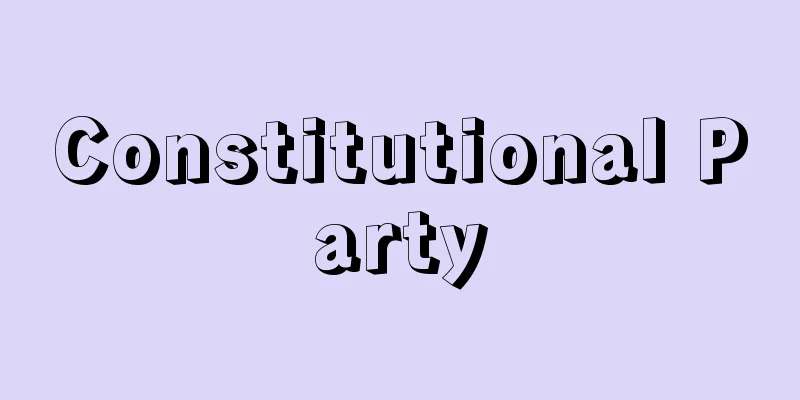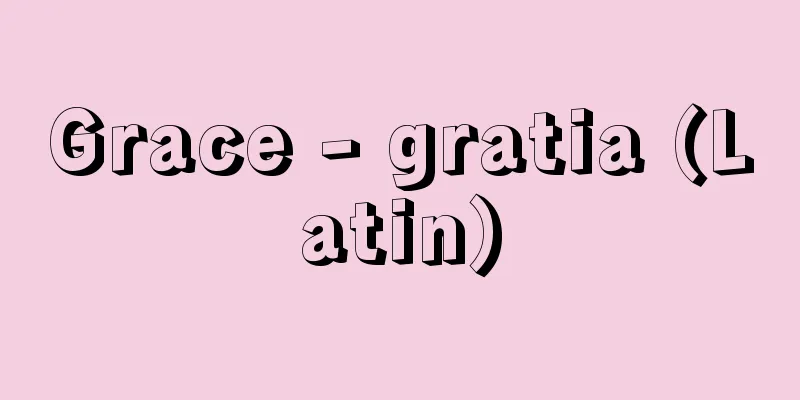Constitutional Party

|
A political party in the late Meiji period. (1) In 1898 (Meiji 31), the Liberal Party and the Progressive Party strengthened their alliance in opposition to the land tax increase bill submitted to the 12th Diet by the third Ito Hirobumi Cabinet, and merged to form a political party on June 22nd after the dissolution of the House of Representatives. It became the ruling party of the so-called Kuma-Itagaki Cabinet (the first Okuma Cabinet), which was organized around Okuma Shigenobu, the de facto leader of the new party, and Itagaki Taisuke, and won an absolute majority of 260 seats in the general election in August. However, demands for government positions within the party were hard to suppress, and attacks from bureaucratic forces intensified after the republican speech incident by Minister of Education Ozaki Yukio. After Ozaki's resignation, the conflict between the old Liberal and Progressive factions intensified over his successor, and they split in October, with the old Liberal faction forming the new Constitutional Party on the 29th and the old Progressive faction forming the Constitutional Party on November 3rd. (2) A political party formed on October 29, 1898 (Meiji 31) mainly by the former liberal faction. In December, the party formed an alliance with the second Yamagata Aritomo cabinet, and voted in favor of the land tax increase bill submitted to the 13th Diet. After the Diet, the government revised the Civil Service Appointment Act to restrict the appointment of party members to government positions, causing unrest within the party, but the party significantly expanded its influence by taking advantage of the conditions of being the ruling party in the prefectural assembly elections that same year. During this time, the party's leadership in the process of maintaining its alliance with the Yamagata cabinet after the split of the Constitutional Party was largely dependent on the skills of Hoshi Toru. After failing to negotiate with Prime Minister Yamagata to have party members join the cabinet in May 1900 (Meiji 33), the party quickly became involved in the movement to form a new political party led by Ito Hirobumi, and on September 13, the party dissolved and participated in the founding of the Rikken Seiyukai party. [Uno Shunichi] [Reference item] | |Source: Shogakukan Encyclopedia Nipponica About Encyclopedia Nipponica Information | Legend |
|
明治時代後期の政党。 (1)1898年(明治31)自由党と進歩党が、第三次伊藤博文(ひろぶみ)内閣の第12議会に提出した地租増徴法案に反対して提携を強め、衆議院解散後の6月22日合同して結成した政党。新政党の事実上の指導者大隈重信(おおくましげのぶ)、板垣退助(たいすけ)を中心に組織したいわゆる隈板(わいはん)内閣(第一次大隈内閣)の与党となり、8月の総選挙で260議席の絶対過半数を獲得した。しかし党内の就官要求は抑えがたく、尾崎行雄(ゆきお)文相の共和演説事件を機に官僚勢力からの攻撃も強まり、尾崎辞任後はその後任をめぐって旧自由・進歩両派の対立が激化し、10月に分裂して、29日旧自由派は新たに憲政党を、11月3日旧進歩派は憲政本党を結成した。 (2)1898年(明治31)10月29日、旧自由派を中心に結成された政党。12月には第二次山県有朋(やまがたありとも)内閣と提携し、第13議会に提出された地租増徴案に賛成した。議会後、政府が文官任用令を改正して政党員の就官を制限したため党内は動揺したが、同年の府県会議員選挙で与党の条件を利用して党勢を大幅に拡張した。この間、憲政党の分裂から山県内閣との提携関係を維持する過程での、党内におけるリーダーシップは星亨(とおる)の手腕に依拠するところが大きかった。1900年(明治33)5月、山県首相との党員入閣交渉に失敗すると、急速に伊藤博文の新政党結成の動きに接近し、9月13日解党して立憲政友会の創立に参加した。 [宇野俊一] [参照項目] | |出典 小学館 日本大百科全書(ニッポニカ)日本大百科全書(ニッポニカ)について 情報 | 凡例 |
Recommend
Cadastral survey
…(2) Land survey: The measurement and mapping of ...
Corvus monedula (English spelling)
… [Yukio Taniguchi]. … *Some of the terminology t...
Dutch iris (English spelling) Dutchiris
…In horticulture, irises are broadly divided into...
materialist Geschichtsauffassung (English spelling) materialistische Geschichtsauffassung
…As can be seen from this example, opinions are d...
The Doctrine and Treatise of Learning - Gakuyoronmo
...A general term for the Chinese Analects, Menci...
Allegorical capital - Guiichiutou
…These capitals were inherited by Islamic archite...
XY type
…In this type, as a result of maturation division...
Vortex - Uzu (English spelling)
When part of a fluid (gas or liquid) rotates like...
Schmidt, EJ
…The process by which eels reach their spawning g...
Kusaurabenitake - Kusaurabenitake
A poisonous mushroom of the Basidiomycete family ...
Rayograph
…In 1921, he went to Paris for the first time and...
Notice disposition - Tsuukokushobun
When tax authorities are convinced of a violation ...
primrose jasmine (English spelling) primrosejasmine
...It blooms in summer, but in greenhouses it blo...
Respiratory division
A specialized medical department within internal m...
Saussurea tanakae (English spelling)
…[Mitsuru Hotta] [Aya Nitta]. … *Some of the term...









